Last updated on February 13, 2024
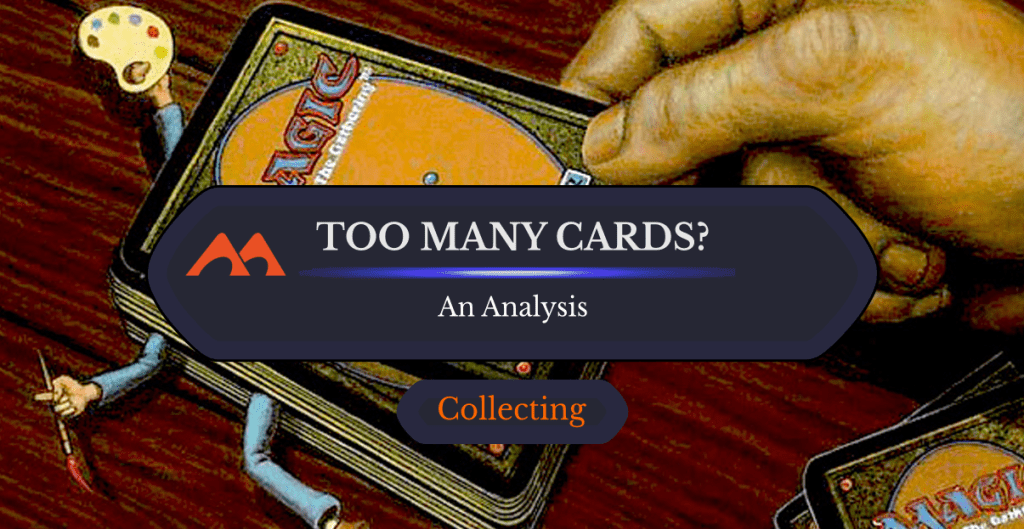
Aesthetic Consultation | Illustration by David Martin
This is perhaps one of the most divisive topics in Magic: The Gathering, and also one of the oldest.
I believe that WotC's current financial results strongly suggest that the overall answer is “No.” Yet I also believe that we can’t think about Magic as a single game (as it was 30 years ago): modern MTG is more like a collection of different games that happen to share game pieces, and some of those games are more welcoming to new pieces than others.
So let’s dive into the hard facts to find out how many Magic cards are printed each year (spoiler: the output has increased in the last five years).
And let’s “follow the money,” and look into Hasbro's financial reports (spoiler: MTG is selling more cards than ever).
With that background, I’ll present different points of view depending on what game mode(s) a Magic player may prefer, which I believe is one of the key reasons why the “Too Many Cards” question lacks a universal answer.
Ready? Let’s go!
Facts First – How Many Magic Cards Are Released Each Year?
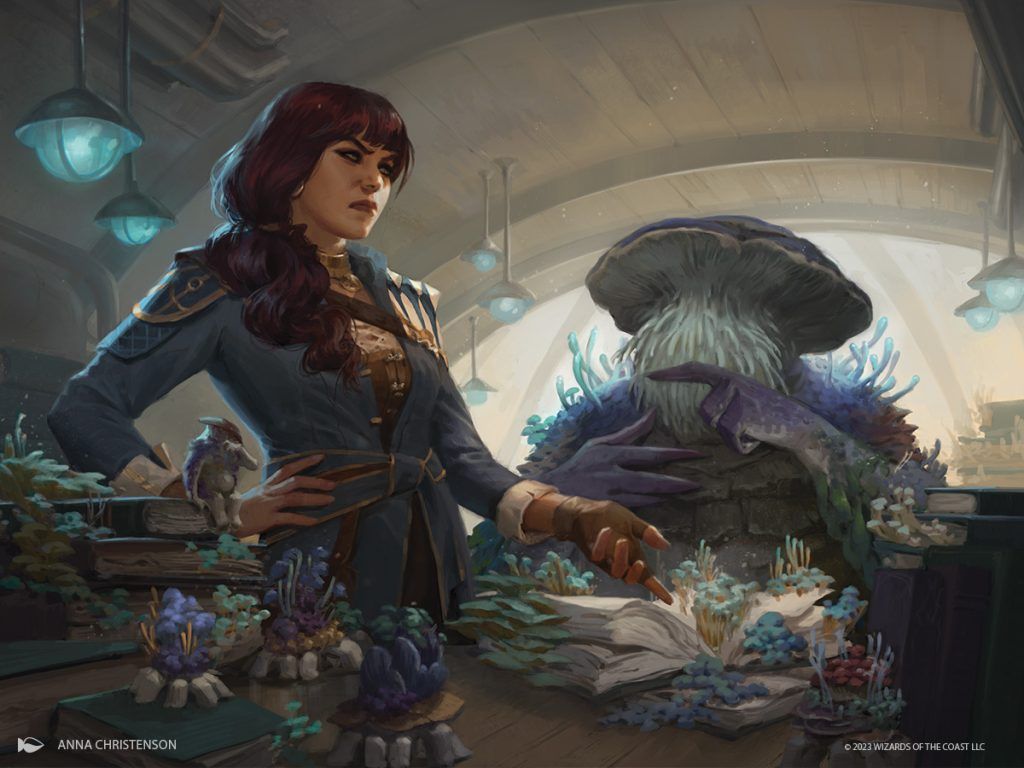
Fact or Fiction | Illustration by Anna Christenson
Here's a graph with a tally of all the Magic: The Gathering products, from 1993 to 2022, grouping them by their icons:
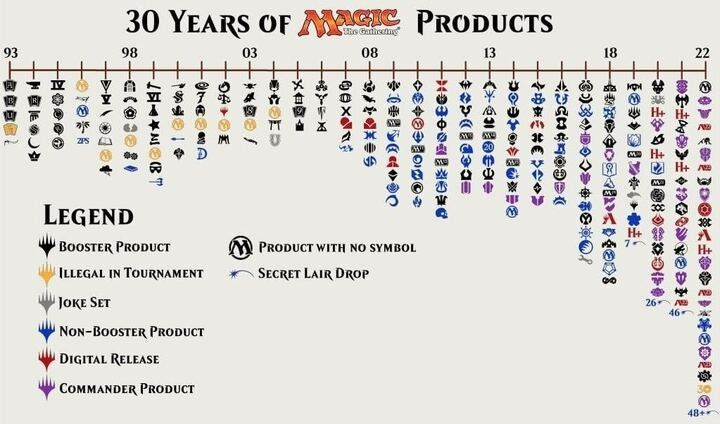
Source: Only On Tuesdays
And here’s a bar graph with the yearly output since 2013. I did this tally by searching on Scryfall with a “year:20xy” query (which provides all cards printed that year) – do note that for 2023, we only have partial results:

So, Fact #1: Card output started to ramp up in 2019, saw a huge spike in 2022, and by August 2023 we've already seen more cards than any whole year prior to 2019. And we still have Wilds of Eldraine, Doctor Who, and The Lost Caverns of Ixalan ahead of us.
Now, that's when looking at all the cards, but what happens when we search for original cards (that's to say, non-reprints)? Here's the comparison, also from a Scryfall query, with the blue bars being the total amount of cards each year, and the red bars representing the non-reprint cards (therefore, the difference in length represents the reprints):
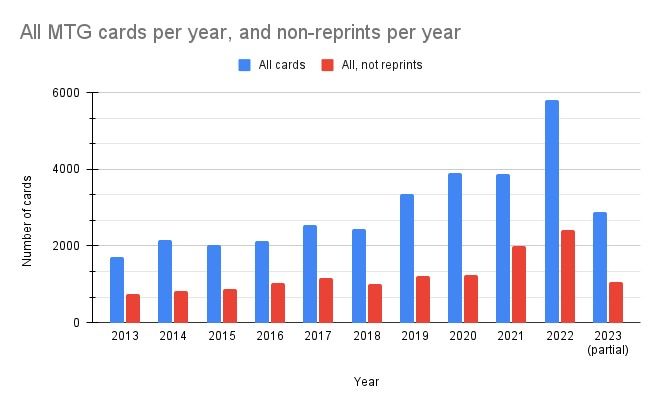
Fact #2: What drove the huge spike of 2022 were reprints.
2023 won't be an exception: the set currently under the spotlight for tabletop Magic is Commander Masters, which is almost entirely a reprint set, and Magic Arena just got the Historic Anthology 7, the Explorer Anthology 3, and the return of the Explorer Anthology 2 – all reprints.
As a third point of reference, here are all the Pioneer-legal cards printed each year (the blue bars), and the Pioneer-legal original cards (the red bars) released since 2013:
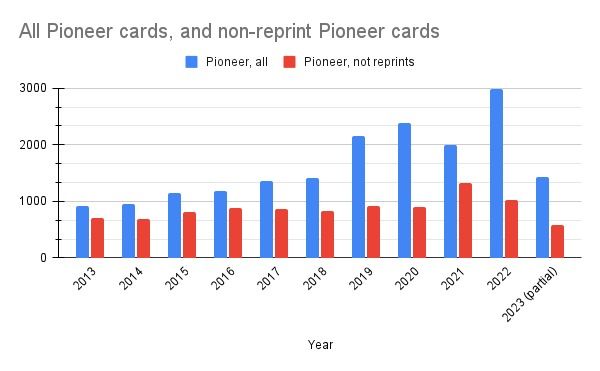
Again, a similar trend: a slight increase in non-reprint cards, and a large increase in the number of reprints.
So, it's an objective fact that Wizards of the Coast is printing more MTG cards, and the bulk of them are reprints.
But, is that too much?
Too Much of a Good Thing?
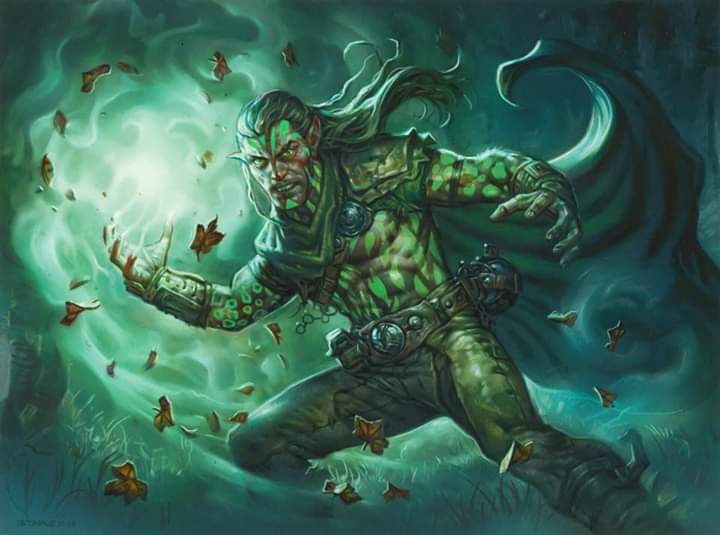
Voice of Many | Illustration by Greg Staples
The “Too Many Cards” topic is as old as Magic itself, as witnessed by this old thread reposted on Twitter by SaffronOlive:
The whole thread linked by SaffronOlive (which is from 1994) is worth a read, but two topics stood out to me, above all for how common they still are: players are worried that WotC will kill Magic by printing too many cards or by printing too powerful cards.
And this is a concern that has recently troubled some very big players in the financial arena. Last year, Bank of America downgraded Hasbro's stock, worried that Wizards of the Coast is killing Hasbro's golden goose by overprinting Magic cards. According to a CNBC article, published in mid-November last year, MTG players “now feel like they can’t keep up with new releases and are instead playing a different version of the card game where older cards can be used.”
A couple of weeks later, Hasbro refuted said criticisms. Cynthia Williams, president of the Wizards of the Coast unit, said that Hasbro doesn’t have any indications of broad declines in interest in the game’s products. “There is no evidence that Magic is overprinted,” she said.
Let's Follow the Money
When looking at Hasbro's stock price, it seems that Bank of America wasn’t entirely off – but not entirely correct, either. This is a graph, taken from Google, of Hasbro's stock price over the last five years:

Source: Google
Hasbro's stock value indeed declined during all of 2022 and well into 2023. But it rebounded last March to values close to what they were when Bank of America issued its warning.
To make matters more complex, Hasbro is a huge company: its product lines range from the Transformers and Peppa Pig franchises to the card game we all love. So how much of last year's stock decline and this year's rebound is related to Magic?
According to Hasbro's First Quarter 2023 Financial Results (from April 27th of this year): “MAGIC: THE GATHERING's first quarter revenues increased 16%. Strong player demand led to higher-than-expected performance for the first quarter release of Phyrexia: All Will Be One. Back catalog sales of previously released sets continue to perform. Modern Horizons 2, released in June 2021, officially became the game's first $200 million set in the first quarter. Universes Beyond Warhammer 40K hit its fourth reprint on strong continuing demand and the newest Universes Beyond set, The Lord of the Rings: Tales of Middle-earth, debuted with record pre-orders in March for a late second quarter release.”
According to Hasbro's Second Quarter 2023 Financial Results from August 3 this year, MTG's Q2 revenue decreased by 11%. This was expected since there was one fewer MTG set released in Q2 this year compared to 2022 – but each of the three sets released in Q2 this year earned, on average, more than each of the four sets in the same time window during 2022:
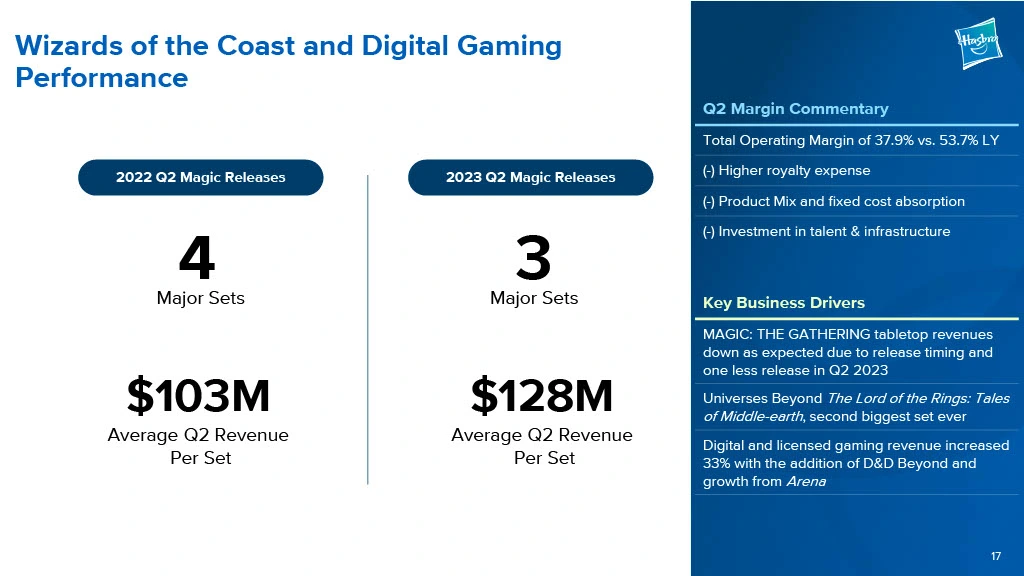
Source: Hasbro Second Quarter Earnings Call
Also, according to the same Q2 2023 earnings report, “The newest Universes Beyond set, The Lord of the Rings: Tales of Middle-earth, was the second biggest launch sell-in ever and is tracking to be the biggest selling MAGIC set of all time. Fans continue to return to organized play as MagicCon Barcelona just finished and the MAGIC World Championships return to Las Vegas from September 22 to 24.”
It's also interesting that the “Wizards of the Coast and Digital Gaming” segment is Hasbro's most profitable when compared with the “Consumer Products” and “Entertainment” segments:
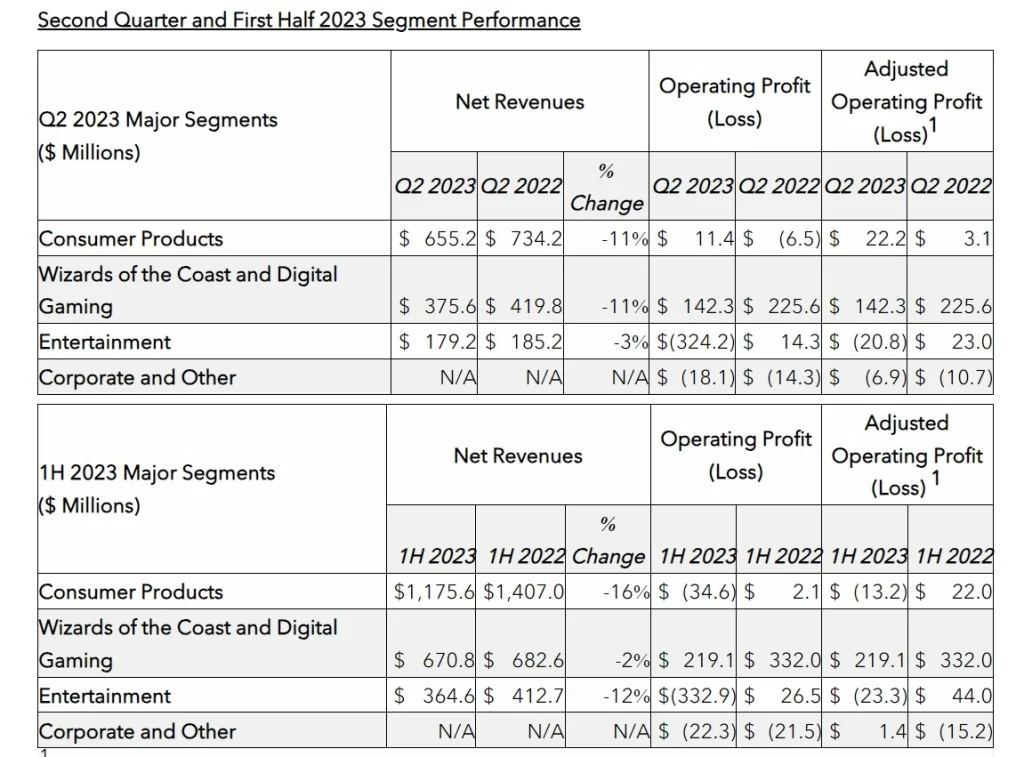
Source: Hasbro
Last but not least: during the Q2 2023 earnings call, Hasbro CEO Chris Cocks said that The Lord of the Rings is right now the second best-selling set of all times, and is expected to become MTG's top seller in just about six months. This is nearly about a fourth of the time it took Modern Horizons 2 to reach this goal.
In short: Magic cards are selling like candy.
State of Design

Natural State | Illustration by Volkan Baga
How do we reconcile the concerns that WotC is printing too many cards – which as we've seen are as old as MTG itself, and are nowadays even echoed by investment banks – with Magic's ramped-up output and record sales?
I believe that we can glean a hint of the answer in Mark Rosewater's latest State of Design article, from July this year.
Rosewater is MTG's head designer, a position he's held since 2003. In his yearly “State of Design” articles (which he has been publishing since 2005), he examines each set released the previous year and talks about the highlights and lessons of that set.
Here is one of Mark's highlights from Phyrexia: All Will Be One:
“The Phyrexian feel permeated throughout the set. The Phyrexians are Magic's oldest villains (premiering in the second-ever expansion, Antiquities). Many players enjoyed how the set truly captured the feel of the Phyrexians from the gameplay to the mechanical themes to the art to the overall look and feel of the cards.”
And here is one of the lessons learned from that same set:
“The Phyrexian flavor was off-putting. While the Phyrexians are beloved by some, they're polarizing characters, meaning there was a swath of players that disliked the set for all the things I just noted above. For those players, the set was too bleak and ‘icky,’ and they wished the set wasn't quite so monolithic in its overall feel.”
Here's one highlight from The Brothers' War:
“Many players liked having a set that looked back at one of Magic's greatest stories. Players liked seeing old characters they recognized in card form. They enjoyed how we conveyed the story through the cards. They enjoyed how the play matched the feel of the story they'd come to know.”
And here's one of the brotherly lessons learned:
“The set was hard to connect to if you didn't know the source material. For long-time fans who have talked about the Brothers' War for years, the set was an exciting opportunity to finally see things they'd heard of come to life in card form. But if you weren't familiar with the story, it was hard to connect with the set since driving force of its structure matched the story. Many less enfranchised players reported they were a bit lost and had trouble connecting with the set.”
You can probably guess where I'm going with this, but since third's the charm, here are one highlight and one lesson learned from Unfinity:
“Some players appreciated that over half of the cards were Eternal legal. Many fans of Un- sets were excited that they could play the cards in formats they formerly couldn't, especially Commander.”
Other players greatly disliked that there were Eternal-legal cards in the set. Many players felt it turned them off the product.
In other words, and paraphrasing the old saying, you can please some people sometimes, but can't please all the people all the time.
So, how do you please most of them, most of the time?
Different Magic Strokes for Different Folks
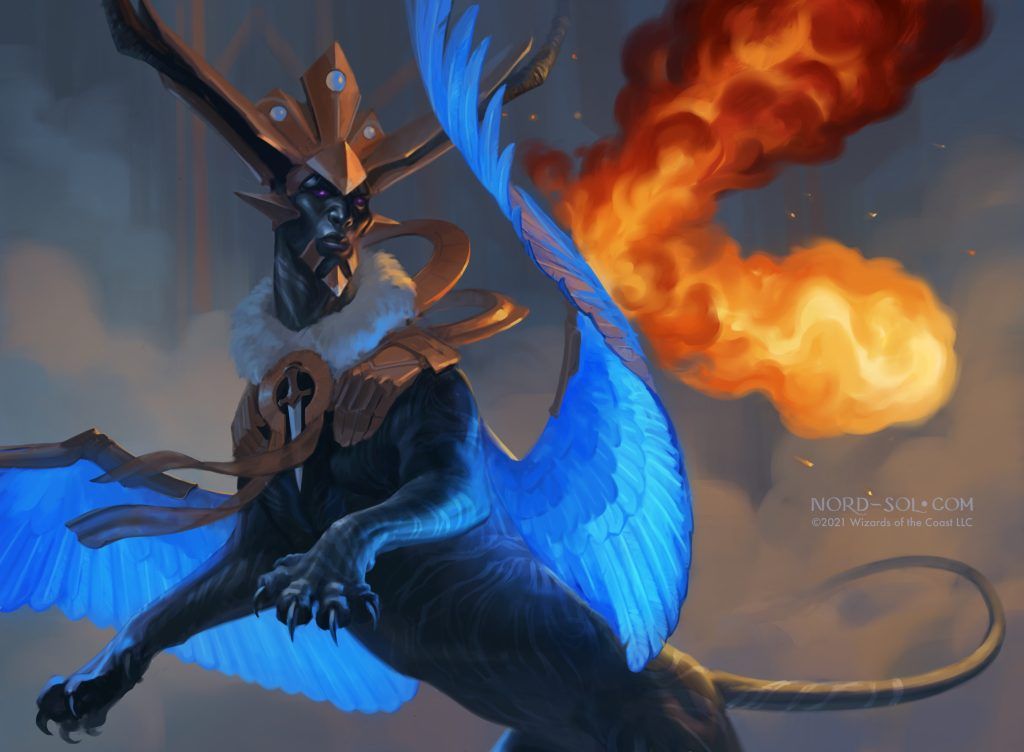
Disdainful Stroke | Illustration by Irina Nordsol
I strongly believe that Wizards is doing the smart thing when trying to please several different audiences: expand their product line and try to make sure that they release something for each of those audiences often enough, even if no one product makes everybody happy.
I believe that's why, taken as a whole, Magic can feel overwhelming: there are simply too many products for any one player to keep up with, but that's because not every product is designed with the same player in mind.
Nobody outside of the upper echelons of WotC has the facts and data to support or refute this claim, though, so in order to support my argument, I'll illustrate with examples from a handful of MTG's game modes.
The “Gotta Catch ‘Em All” Game
As should be clear to anybody with a bank account smaller than Elon Musk's, collecting all the cards in Magic isn’t a game we can play. Maybe 30 years ago, but now, that's just not happening.
But the success of Collector Boosters suggests that there's a sizable share of the player base that’s happy to have a deluge of luxurious collectibles to choose from and buy those that resonate with them.
Fun fact: MTG Collector Boosters were launched in early 2019 – the same year when overall product output started to ramp up.
Drafters
As a drafter myself, I've noted that interest in any particular set tends to wane after a couple of months when most formats are considered “solved.” Having a new set to draft is always welcome.
We also tend to enjoy having access to a variety of formats, and Wizards has been keen on meeting this demand by releasing reprint sets (like Dominaria Remastered for tabletop, or Shadows over Innistrad Remastered for Magic Arena) that are designed with Limited in mind.
It goes without saying that not all draft formats are equally liked, and the product's price is indeed a concern…
… but I'd hazard a guess that drafters would be happy to have the option of a new set to draft every six or seven weeks. In that regard, we're not at “maximum capacity” yet. WotC could churn a (fairly priced, solidly designed) draftable set every other month and we'd be pretty happy about it.
Commander
As seen in the 1994 post quoted by SaffronOlive, there has always been a concern that players too focused on competing and playing the “killer decks” would kill the fun out of Magic.
Commander, a mostly-casual and multiplayer format, seems to be Magic's solution to the “Spikes with killer decks will kill the fun” problem, and also the one format where personal expression shines the most. Not being a dedicated Commander player myself, I asked two of my fellow Draftsim authors about their views on current product output.
“I really like most recent sets,” Ignacio says, “but they all feel like they came and went way too quickly, which in turn means there are a lot of mechanics that we only see in one set, or may take a long time to become viable. Take Food, for example, it's been around for years, but it was only with the recent Lord of the Rings set that it became a viable Commander strategy.”
“The current output also makes the pacing go faster. The story needs to accommodate jumping from one plane to the other every two months, and there's always a spoiler season where the entire setting is supposed to feel new, which is overwhelming. I just wanna hang out in each new plane we visit,” he said.
Timothy Zaccagnino shares Ignacio's opinion about the 2021-2022 period being overwhelming. “2023 has been more manageable, though,” says Tim. “Secret Lairs have slowed down this year, and there haven't been as many supplementary sets as the previous two years.
“It's still a bit much to get multiple Commander decks per release, especially when the number isn't consistent (some sets have 2, some have 4-5). The Commander precons are very well put together, but releasing them with every set has made it unrealistic to keep up with new printings, new reprints/art, card prices, etc,” he said.
Pioneering Stability
Pioneer is a non-rotating format that allows expansion sets and core sets from Return to Ravnica forward, and which was introduced in October 2019 – the very same year when card output started to increase by a lot, and when Collector Boosters were introduced.
As of late, WotC has positioned Pioneer as one of the main formats for those who enjoy playing the “killer decks”, with Pioneer being the focus of several Regional Championships this year (with Modern, also a non-rotating format, enjoying the spotlight during the second half). As far as new cards go, Pioneer is fairly stable, with very few new cards each year becoming relevant. As seen in Frank Karsten's Metagame Mentor from July 13, most of the best Pioneer decks in July were also among the best-performing archetypes at last year's Regional Championships and Pro Tour Phyrexia.
That's not to say that new cards don't impact Pioneer. The second most popular archetype, mono-green devotion, now includes Polukranos Reborn from March of the Machine – but, overall, with the card pool being so large, only a small fraction of the new cards make an impact, thus greatly diminishing the “Too Many New Cards” effect.
Then again, you just can't please everybody, and when there aren’t enough cards to make a format interesting, then…
Explorer: Quality Above Quantity
Explorer is a format unique to Magic Arena: it encompasses all the Pioneer cards that exist on Arena, but as of now only around 70% of the Pioneer cards are available on MTGA.
Explorer is one clear example of a game mode in which players are asking (or, well, “yelling” may be a more accurate term, although some are resorting to humor) for more cards – there's even a Support Ticket on the topic, with a lot of upvotes.
In particular, what (vocal) Explorer players want are the 30-ish or so cards that would make pretty much all top-tier Pioneer decks playable on Arena.
It's an interesting case of quality versus quantity: there are around 2,900 Pioneer cards that aren’t yet available on Arena, yet you just need around 1% of those cards if what you want are the top-tier Pioneer decks. This further illustrates why non-rotating formats like Pioneer are more “resilient,” so to speak, to new cards. The bigger a format's card pool, the less impact new cards will have (on average) since only a few are strong enough to matter, thus partially shielding these formats from the “Too Many Cards” problem.
But such resilience to new cards has a drawback.
Back in 2019, one of WotC's stated goals for Pioneer was to provide a non-rotating format where Standard cards would rotate into – by 2019, Modern's card pool had become so large that it no longer served the needed role of “format where you can use your Standard cards after rotation.”
Pioneer was designed as that “retiring home” of sorts, where Standard cards could see play after being rotated out. But as Pioneer's own card pool grows larger, Standard cards have a harder time shining there once they rotate.
Standard
Standard is an interesting case. For starters, it's the only rotating format in tabletop Magic (in Arena, there's also Alchemy), and although it shows a spike in product output in 2021, it isn’t as egregious as we've seen for other formats:
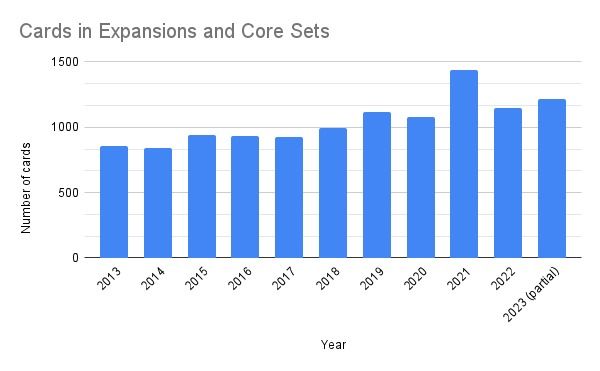
Tabletop Standard has been waning, though. As Jake Henderson wrote in December last year, “The problem with Standard isn’t that it’s too expensive now compared to previous years or that there are too many problem cards, it’s that the investment in a Standard deck doesn’t have the same longevity it once had.”
The underlying reason is that one of WotC's recent trends has been the increase of supplemental products. This often means that nowadays, the most powerful cards for non-rotating formats are printed in a supplemental set (rather than in Standard). For example, just ask any Modern or Historic player about The One Ring or Orcish Bowmasters, both printed with The Lord of the Rings, a non-Standard set.
As Jake notes, “Players can’t realistically use a lot of their expensive Standard cards in other formats because their power level fades compared to many cards from supplemental sets. There needs to be another incentive to get players to buy Standard-legal cards.”
WotC is aware of the decline of tabletop Standard, which is all the starker in contrast to how well other formats are doing. In their “Revitalizing Standard” article back in May, WotC notes that: “Even in the context of Magic growing leaps and bounds over the past few years, tabletop Standard hasn't kept pace. Commander has grown tremendously. More and more players enjoy Pioneer and Modern. And Standard sees more play on Magic: The Gathering Arena every day than individual games in any other format.”
WotC's first step for revitalizing tabletop Standard is the new rotation cadence: sets now rotate out every three years rather than every two years. According to WotC, “This will give current Standard cards more longevity. Time and again, we hear that players want to play with cards they love and enjoy longer. Standard is our only rotating format, and while keeping it fresh is important, we also feel that there's a more effective middle ground.”
In my opinion, this also makes new cards a bit less impactful (at least for those playing the “killer decks”): as shown by non-rotating formats like Modern, Pioneer, and Explorer, the bigger the card pool, the less impactful new cards tend to be.
The One Game… Not Anymore
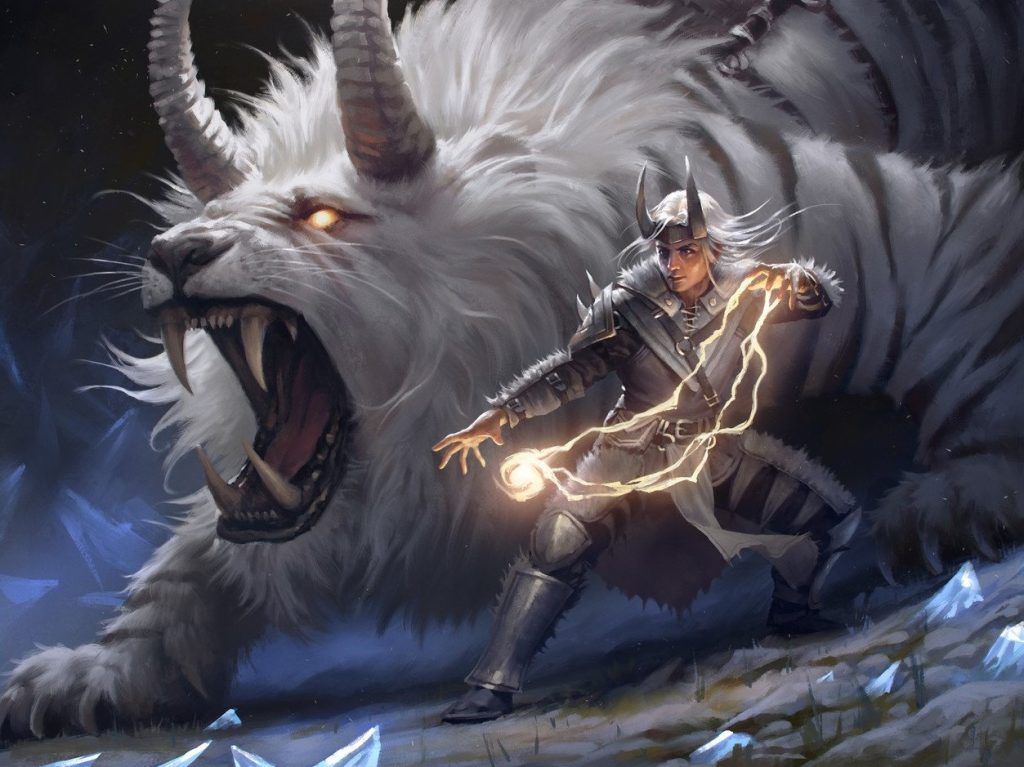
Fight as One | Illustration by Bryan Sola
I believe that it's a bit misleading to look at modern Magic as a single game, as it was back in 1994. Magic has evolved into several interlocking formats and game modes and is played across several platforms, so whether too few or too many cards are printed each year depends a lot on your preferred format(s).
Mark Rosewater seems to think along those lines. Here's Mark's reply, on his personal blog, to a player disillusioned from the inclusion of “Universes Beyond” cards:
“I get asked a lot why Magic players stick with the game as long as they do,” Mark writes. “The average length of a Magic player (now well over ten years) is longer than the average game exists. Why is that?
“I believe the number one reason is the game’s evolution. It isn’t a game that sits still. It’s constantly adapting. It’s not the game I initially fell in love with in 1993. But then, my wife is not the woman I fell in love with back in 1996. In both cases, they changed and got even better,” he said.
When it started, Magic was indeed a single game. But nowadays, a drafter on Magic Arena, a Pioneer player on Magic Online, and a Commander player in paper, in practice, all playing different games, even if they’re all playing Magic.
Magic is also no longer a single multiverse. Some players were delighted to add The Walking Dead cards to their zombie decks; others disliked the thought of Rick Grimes head-shooting Liliana Vess.
Since it's probably impossible to please all the people all the time, I think Wizards of the Coast is doing the smart thing: it has transformed Magic into several interlocking games that happen to share the pieces, and they’re encouraging us to engage with the modes and game pieces we enjoy the most.
As Timothy Zaccagnino said when I asked for his opinion about this topic, “I think the onus is partly on the player to say to themselves that they don't need everything that comes out, and I find it interesting and exciting that people can play cards against me in 2023 that I'd never seen before. In 2020, I could tell you pretty much anything people were going to play.”
Wrap Up

The Deck of Many Things | Illustration by Volkan Baga
Wizards has been printing more Magic cards; that's an objective fact. And according to this year's Q1 and Q2 financial reports, they are selling well; that's a fact, too.
I believe that, past that point, it's largely a subjective opinion. But I hope that this article illustrates why evergreen worries about there being too many cards coexisting with record sales: Magic isn’t a game. It's many games. And WotC has, in the last five years, made an effort to make sure each of their many Magic games receives enough pieces.
I hope you've found this long read engaging, and if you'd like to discuss and debate further, just give me a ping on Discord!
Stay safe and see you later!
Follow Draftsim for awesome articles and set updates:

1 Comment
I disagree. It’s a well thought out and defendable argument, however there is no denying the new direction from this CEO, who’s days are numbered. Mucho deniro every quarter…growth at all costs.
We need only to look at 1993-ish in comic books when there were TONS of new #1’s new “1st appearances” multi cover variants etc. They too thought everything was AMAZING when you look at the $$$ numbers…right up until it isn’t. The industry collapsed and Marvel went bankrupt.
Likewise, the reprints are part of the “too many cards”. They are killing the collectible market. Yes, MTG is a different game now, it Is not one single game either. I agree. Collecting cards and the secondary market is its own game. That one is being destroyed. Many players survive in the game by selling old cards to get new ones for the format they want to play. The reprints kill the value.
If I’m buying new packs just to get reprints, that is a hidden increase to the cost of new cards. I was playing MTGA and quit over the new rotations and too many nerfs and bans. It was just too much to keep track of.
We need to have 1-2 cards each set go on the Reserve List…even if it’s a common card. It would be a nice olive branch to the collectible market.
MTG may have more time on its way up, but eventually everyone will say enough is enough. The capitalism cycle (mutter, mutter), and all of us consumers are always the victims.
Add Comment